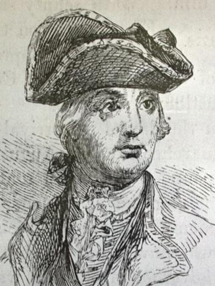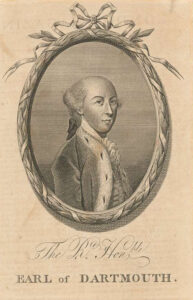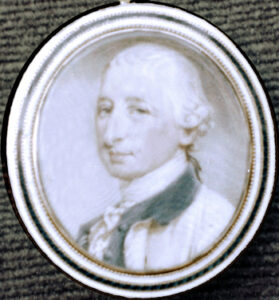The Royal Governor of the Colony of North Carolina, Josiah Martin, was young and dedicated to the Crown. His popularity was waning as he urged members of the Assembly on April 4, 1774, to resist the monster of sedition that was raising its ugly head in the colonies. He knew that his appeals fell on deaf ears because three days later, he wrote to Lord Dartmouth, the Colonial Secretary of State in London, that the government in North Carolina was impotent and only a shadow of its former self. The local population was aware of Governor Martin’s strong Loyalist tendencies, and the Patriots began establishing militia companies around North Carolina in case a stronger opposition to royal authority was required. The friction between Loyalists and Patriots is best captured in Martin’s correspondence with Lord Dartmouth. On April 6, Martin wrote to Dartmouth while he was in Newbern, North Carolina,
The duty I owe to the King, my sincere zeal for His Majesty’s service, and my anxious desire to support with dignity and firmness the just measures of His Government oblige me to lay before your Lordship, for His Majesty’s consideration, the conduct of a majority of the Council of this Province at the late Session of the General Assembly, which has appeared to me highly unworthy and unbecoming, and in its tendency greatly injurious to the inseparable interests of Government and this Country. . . . I confess to your Lordship I was exceedingly surprised at this conduct so inconsistent with the dignity of the Council, and my sense of its duty to government, which I had carefully & designedly enlarged upon at the Board on the opening of the Session: and set before it, in the strongest manner I was able, the particular need there was of the Council’s utmost support at a time when the representatives of the People were blindly opposing its just measures, and urging their Country’s ruin.[1]
As local opposition to British authority increased, Martin abandoned the capital at New Bern while directing that all royal cannons be spiked and ammunition buried in the cellar. He fled to the safety of Fort Johnston on the Cape Fear River on June 2.
Dissention and the lack of supplies prompted Martin to meet with his dwindling Council (those sympathetic to the Patriot cause left on June 25). Their meeting resulted in the decision to recruit replacements for the garrison and issue militia commissions. This prompted Martin to write to the commander in chief of British military forces in North America, Gen. Thomas Gage, requesting funds to repair and strengthen the fort.

The Wilmington Committee of Safety learned of Martin’s efforts and issued orders forbidding all local communication with the fort while they sent alerts to local militia leaders. On July 15, 1774, militia leader Col. Robert Howe gathered his men in Brunswick and marched to seize Fort Johnston. Surprisingly, Howe sent a letter to Governor Martin in advance, notifying him that he was en route to remove the guns from the fort. Howe believed that the fort was so dilapidated that it was not defensible. The Patriots arrived on July 18 and found the fort vacated, and the governor and his small force aboard the British Royal Navy sloop Cruizer. The Patriots burned the fort and all structures in the vicinity of the post.

The population of North Carolina was growing increasingly resistant to British leadership. On March 23, 1775, Governor Martin again wrote to Dartmouth, highlighting the hostile New England preparations that had spread to Virginia. His concern caused him to write to General Gage requesting arms and ammunition to arm all citizens who remained loyal to the King.[2] Martin had been an army officer before his political career, rising to the rank of lieutenant colonel in the 68th Regiment of Foot before resigning in 1770 at the age of thirty-three. Now, he requested that his military rank be restored to better support his military authority, but Dartmouth declined his military reinstatement. Over the next several months, it was clear that Martin’s words went unheeded, and he was losing support and control of North Carolina. He devised a plan to regain control of the colony if only the King would dispatch men, arms, and ammunition to equip up to 20,000 men who would rise to suppress the rebellious Patriots. The plan required support from General Gage, and Martin assured Dartmouth that 10,000 arms and artillery, and restoring his commission as a lieutenant colonel, would be enough to quell the rebellion and rally Loyalists. On October 16, 1775, Martin wrote to Dartmouth complaining that General Gage failed to respond to his request for arms and ammunition after seven months. He claimed,
Still My Lord if I ever am supported I shall not fail to employ every effort to regain my lost ground which may not yet be impossible altho I confess nothing can be more discouraging than my present prospects. . . . After all however I am yet induced to hope that if the present unnatural contest should continue and government shall think proper to try effectually is strength in the Province it will be found that the Scotch here have only been dormant for want of support and that they have not lost their loyalty or love of their Mother Country and if it is though advisable My Lord to aid me with two Battalions.[3]
Martin counted on a large group of Scottish Highlanders who had recently immigrated to North Carolina who remained loyal to the King. Martin also requested that King George III pardon the defeated and abused Regulators, citizens who had rebelled against corrupt colonial officials in 1771.[4] Martin convinced Loyalist Alexander Schaw to deliver the letter to London and explain the plan to Lord Dartmouth, claiming he could control the southern colonies with the Highlanders, former Regulators, and other Loyalists.

Support would soon be on the way. In late 1775, seven British regiments under Gen. Charles Cornwallis, on transports accompanied by nine warships under the command of Admiral Sir Peter Parker, were preparing to sail from Ireland to land in the Cape Fear River area. The plan was relayed to Gen. William Howe, who had replaced General Gage as the British commander-in-chief in America on October 1, 1775.[5] Howe was to send some troops from Boston to support the North Carolina campaign. On November 7, 1775, Dartmouth wrote to Martin that a full examination of the Cape Fear River’s entrance and navigation proved it to be hazardous and impractical for larger vessels, and that British troops would receive no protection from ships of war during their landing.[6] Dartmouth also wrote that a smaller landing might be possible if joined by and supported by Loyalists in the region. If landing off the Cape Fear River was impractical and ill-supported, the British force would proceed to Charles Town, South Carolina.[7]
British officials in London knew North Carolina and Georgia were the weakest colonies in America. They also knew that most of the rebels in North Carolina were in the coastal areas. Large numbers of Scottish immigrants, backcountry settlers, or ex-Regulators would join the Crown or at least remain neutral. However, Martin’s predictions on the number of Loyalists were exaggerated and only half correct.[8]
Battle
On January 10, Gov. Josiah Martin requested a call to arms for all Loyalists in the area. Many who assembled at Cross Creek (near modern Fayetteville, North Carolina) were of Scottish ancestry. Brig. Gen. Donald MacDonald, whose extensive experience as a former British officer during the Jacobite uprising of 1745, led a group of approximately 600 Scottish immigrants and 800 North Carolina Loyalists, many of whom were Regulators. On January 12, 1776, Martin claimed to Dartmouth that “The people called Regulators (for whom I hope before this time to have received his Majesty’s Pardon) to the number of between two and three thousand men have given me the strongest assurances of their joining the King’s standard whenever they shall be called upon.”[9] While he was clearly exaggerating to Dartmouth given he only had 1,400 volunteers, he was attempting to shape London’s perception to collect additional support.
On February 18, MacDonald marched toward the coast to rendezvous with the commander of the awaited British troops, Maj. Gen. Henry Clinton, who would, after landing, work with him to support Governor Martin. MacDonald led his men towards the planned meeting point of Negro Head Point near Wilmington. Over a thousand Patriots planned to stop MacDonald and his men at Black River, which feeds into the Cape Fear River. An enslaved person alerted MacDonald and his Loyalists to an undefended crossing, forcing the Patriots to shift to the south bank of Moore’s Creek, seventeen miles from Wilmington. Militia leader Col. Richard Caswell recorded a few details of the Patriot movements: “Our army was about one thousand strong, consisting of the New Berne battalion of Minute-Men, the Militia from Craven, Johnston, Dobbs, and Wake, and a detachment of the Wilmington battalion Minute-men, which we found encamped at Moore’s Creek the night before the battle, under the command of Colonel Lillington.”[10]
Unfortunately for the Loyalists, General MacDonald fell ill, and command fell to Lt. Col. Donald McLeod, a less experienced officer, who elected to attack the following morning. Preparing for the Loyalist approach, Caswell’s men removed the bridge planks and constructed earthworks on the creek’s east bank. Shortly after midnight on February 27, McLeod formed his men and headed toward the bridge, though most of his men deserted and only 900 men remained, mostly Highlanders. They soon ran into Caswell’s pickets, who alerted the main Patriot force. Shortly after, the Loyalists clashed with over 1,000 Patriots led by Continental Col. James Moore along with Colonel Caswell. As the fighting intensified, Loyalist Capt. John Campbell rallied the Highlanders to charge the bridge, leading his company across the creek.

A Hollywood-like scene played out when 600 Scottish Highlanders clad in tartan garments and feather in their bonnets, wielding claymores—traditional Scottish broadswords with blades four to five feet long—attempted to cross the bridge. The missing planks slowed their progress as they tried to storm the bridge by walking on the stringers, to the sound of bagpipes. As McLeod and his men approached the Patriot works, Caswell opened with muskets and artillery fire. The volleys devastated the Loyalist ranks and forced them to retreat. Elated with their success, the Patriots launched a pursuit, chasing the Loyalists from the field. The disastrous charge killed or wounded 50 Loyalists, while most of the remainder were captured. Many historians write that there were mostly Highlanders and Regulators defeated at the battle; from the list of prisoners, militia Col. William Purviance noted that there were “not 200 of the old Regulators among” those captured.[11] Only one Patriot was killed and one wounded.
The noted historian George Bancroft studied source documents, publishing multiple editions of his History of the United States of America from the Discovery of the American Continent (1854). Bancroft wrote that mounted men, infantry, and artillery were engaged in the campaign up and down Moore’s Creek Bridge for over sixty miles.[12] While only about 900 Loyalists were engaged in the battle at the bridge, there were reports ranging from 1,500 to 3,000 in the region. A letter dated March 10, 1776, from an unknown source but clearly someone who had first-hand knowledge of the battle wrote,
Parties of Men are dispersed all over the Colony, apprehending all suspected persons, and disarming all Highlanders and Regulators that were put to the rout in the late battle. The Conquerors have already taken 350 guns and shot-bags; about 150 swords and dirks; 1,500 excellent rifles; two medicine-chests fresh from England, one of them valued at 300 pounds sterling; also thirteen wagons with complete sets of horses, 850 common Soldiers were made prisoners, disarmed and discharged.[13]
The author went on to name those captured and wounded. Josiah Martin’s letter to George Sackville Germain (who replaced Lord Dartmouth as Secretary of State for the American Department on November 10, 1775) explained the Tory defeat, writing that while he expected five thousand men to rise up and stamp out the Patriots, far fewer assembled while the rebels marched with 1,400 men.[14] Martin also mentioned that if the King’s troops arrived under General Clinton, there was little support to meet them at the shore as few Loyalists were willing to support British troops given the large Patriot turnout in the region.
Roughly sixty years later, James Devane, who served with the Patriot militia, appeared in court to claim his pension and recount his experience at the battle. He described his comrades digging trenches near the bridge. He told the panel that early on the morning of February 27, the Loyalists attacked, and most failed to make it across the bridge because the Patriots removed most of the boards. He did admit that two Loyalists made it across the bridge before they were shot and killed. He recalled that both Loyalist leaders, Col. McLeod and Capt. Campbell were killed on the other side of the creek.[15]
A letter from Col. Richard Caswell to Cornelius Harnett, president of the North Carolina Provincial Council, clarified some of the details about the Battle of Moore’s Creek. Caswell reported on the number of Loyalist militia in the area, which was much greater, though only 900 were involved in the battle at the bridge. He wrote,
The Tories, by common report, were three thousand; but General McDonald, whom we have prisoner, says there were about fifteen or sixteen hundred; he was unwell that day and day on the battle. Captain McLeod, who seemed to be principal commander, and Captain John Campbell are among the slain.[16]
While the British plans for North Carolina were viable, their principal flaw was that they did not factor in strong resistance to the Crown.[17] After a month-long campaign, the culminating battle at Moore’s Creek foiled British plans in the South.[18] With the loss in North Carolina, the fleet under Adm. Sir Peter Parker and Gen. Henry Clinton diverted south towards Charles Town, South Carolina, where they attempted to assault the city from the sea failed on June 28, 1776, denying the British the use of the vital strategic seaport. The Patriot victory secured American control of North Carolina and served as a major deterrent for Loyalist recruiting until the opening of the British Southern Campaign four years later. After MacDonald’s defeat, many Tories remained quiet, while Patriot leaders were more daring, and many citizens tried to avoid taking sides altogether.[19]
[1] Josiah Martin to William Legge, Earl of Dartmouth, April 06, docsouth.unc.edu/csr/index.php/document/csr09-0261.
[2] Martin to Dartmouth, March 23, 1775, docsouth.unc.edu/csr/index.php/document/csr09-0389.
[3] Martin to Dartmouth, October 16, 1775, docsouth.unc.edu/csr/index.php/document/csr10-0114.
[4] Martin to Dartmouth, March 23, 1775, docsouth.unc.edu/csr/index.php/document/csr09-0389.
[5] Preface to Volume 10 of Colonial Records of North Carolina, docsouth.unc.edu/csr/index.php/document/csr10-es01.
[6] Darmouth to Martin November 7, 1775, docsouth.unc.edu/csr/index.php/document/csr10-0126.
[7] Darmouth to Martin November 7, 1775, docsouth.unc.edu/csr/index.php/document/csr10-0126.
[8] Woody Holton, Liberty is Sweet: the Hidden History of the American Revolution (New York: Simon and Schuster, 2021), 23.
[9] Martin to the Dartmouth, January 12, 1776, docsouth.unc.edu/csr/index.php/document/csr10-0195.
[10] Richard Caswell to Cornelius Harnett, February 29, 1776, docsouth.unc.edu/csr/index.php/document/csr10-0237.
[11] Preface to Volume 10 of Colonial Records of North Carolina, docsouth.unc.edu/csr/index.php/document/csr10-es01. Purviance and his men were stationed along the Cape Fear River at various locations near Wilmington and north of the town of Heron’s Bridge.
[12] Ibid.
[13] “Letter from an inhabitant of North Carolina,” docsouth.unc.edu/csr/index.php/document/csr10-0241.
[14] Martin to George Sackville Germain, Viscount Sackville, March 21, 1776, docsouth.unc.edu/csr/index.php/document/csr10-0242.
[15] The Colonial and State Records of North Carolina, docsouth.unc.edu/csr/index.php/document/csr15-0740, page 785.
[16] Caswell to Harnett, February 29, 1776, docsouth.unc.edu/csr/index.php/document/csr10-0237.
[17] Preface to Volume 10 of Colonial Records of North Carolina, docsouth.unc.edu/csr/index.php/document/csr10-es01.
[18] Ibid.
[19] Preface to Volume 11 of Colonial and State Records of North Carolina, docsouth.unc.edu/csr/index.php/document/csr11-es02#p11-x.










7 Comments
Rough moments
yes they were
Well written accurate account of the feelings of resentment that was about to transform our nation!
Thank you. They were tumultuous times.
So sad then as now again today- of the dedication by many to autocracy rather then grasp and embrace what “freedoms under Liberty” should mean to them and posterity…!
very true